“It is a monstrous love and it makes monsters of us all”
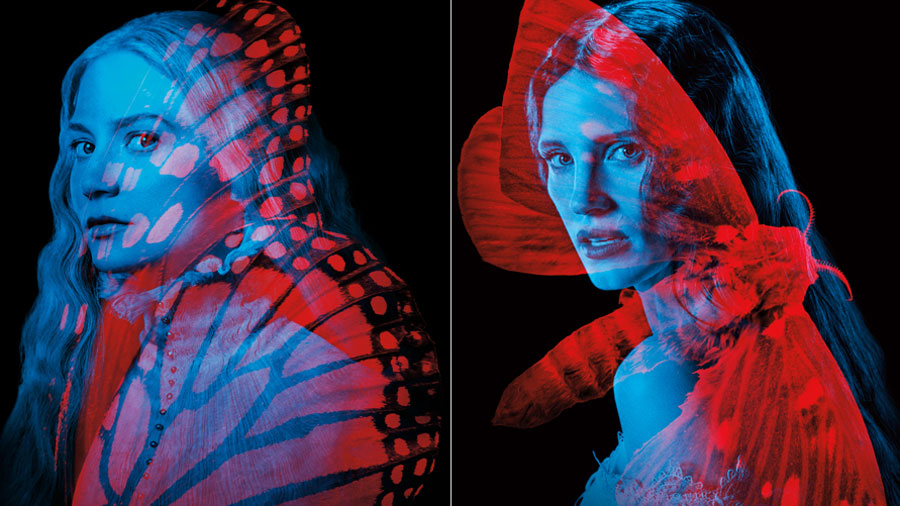
Guillermo Del Toro’s gothic romance Crimson Peak is a carefully designed visual masterpiece that centres around American heiress Edith Cushing (Mia Wasikowska), an aspiring author who becomes romantically involved with English baronet Thomas Sharpe (Tom Hiddleston) when he visits New York seeking investment from her father for his clay-mining invention. After her father’s brutal and mysterious murder, Edith and Thomas marry as he sweeps her from bright and bustling Buffalo to his cold and dilapidated Cumberland estate, where he lives with his sister Lucille (Jessica Chastain). The locations are not only juxtaposed, but so are the two women, Edith represented by beautifully coloured butterflies and Lucille by mottled black moths. Del Toro’s Lynchian symbolism denotes death and darkness, with scenes of horror and deviant sexuality presaged by the presence of the moths that haunt the Sharpe mansion.
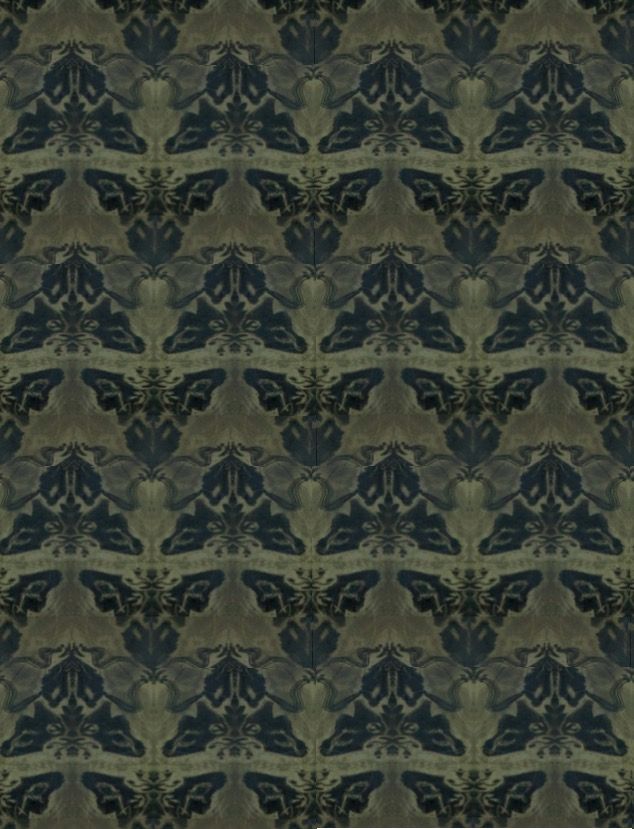
As a gothic romance, Crimson Peak has its origins and takes many notes from classical literature. Animals are often present in Gothic literature, usually dark in both colouring and symbolism. Crimson Peak relies heavily on costume and set design and therefore this symbolism becomes a part of a rich visual language, the moth imagery incorporated into several details like the wallpaper (Fig. 1), the architecture, and the costuming. The Victorian era saw Darwin’s evolutionary theory, one that revolutionised human perception of animals, the other or the outsider was introduced into the human realm. Subsequent anxieties saw animals commonly feature in Gothic works, not as irrational or wild but closer to humanity than previously envisioned. They are omens, harbingers of evil and death, perhaps aware of something that we are not. Recurring animals in Gothic fiction include black cats, bats, wolves, and dogs, though Crimson Peak uses insects, specifically Lepidoptera, as its symbol of gothic darkness. Del Toro, born in Mexico, injects some of his own culture as the Black Witch Moth is known as mariposa de la muerte, or the butterfly of death, since the Aztec period in Mexican mythology[1]. This darkness grows inside Lucille as an abused child and feasts in Allerdale Hall, specifically in areas of the house where horrors have taken place, like the attic. The imagery is cleverly disposed throughout the whole film, the filmography creating an extensive metaphor that is contrasted against Edith, draped in golden light as the film’s butterfly.
The animal allegory begins to take significant form in the park scene (Fig. 2). Filled with a warm golden light, which will later contrast the cold darkness of Allerdale Hall, the difference between the Sharpe siblings and their surroundings is clear. Both don black monochromatic clothing, Thomas wearing a particularly bug-like pair of spectacles. The focus, however, is on the two women. Sitting side by side, Del Toro encourages the audience to make comparisons. The costuming effectively mirrors the character of each; Edith’s light puffy sleeves resemble butterfly wings, the bodice of her dress and hat are adorned with flowers, the gold and black accents directly parallel the dying butterflies that she and Lucille discover on the floor. She thrives here in the light of New York just as the butterflies do. Lucille, on the other hand, wears dark, mottled clothing with chunky lace trimmings which imitates the wings of a moth. Her hat is a visible grimace rather than bright and floral like her counterpart. The black clad is only broken up with a red stain on her lips and a matching red flower laid over her heart, symbolising her love and lust as well as blood.
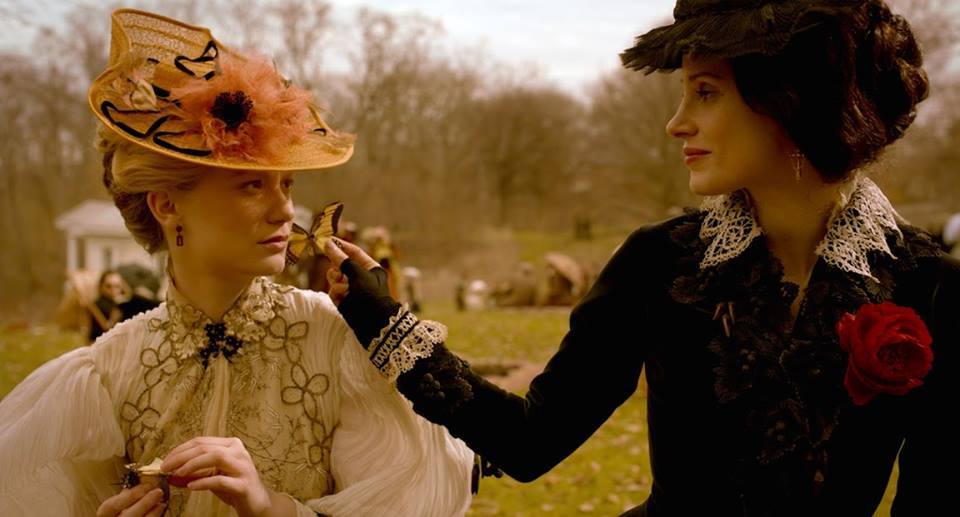
The women discuss the brutality of nature, on the surface solely about moths and butterflies, but its undercurrent actually analogises their relationship with each other. Lucille explains, “[The butterflies are] dying. They take their heat from the sun and when it deserts them, they die. […] Beautiful things are fragile.” She holds the butterfly up to Edith’s face (Fig. 3), making a direct comparison, her opinion of them the same that she holds for Edith. Lucille preys on this fragility as she explains the black moths that reside at Allerdale Hall feed on butterflies. This all foreshadows Edith’s supposed fate; the formidable moth conquers over the fragile butterfly as Lucille plans to murder Edith for her wealth after she marries her brother. Although the women are confined to these binaries, this scene is significant as it marks the complexity of Lucille’s character. The scripting gives the sun agency, actively deserting the butterflies letting them die and therefore insinuating that if Lucille were given a warm and bright home, like Edith, she could be a butterfly as well. We see Edith have a loving relationship with her father, but Lucille and Thomas were subject to an abusive mother who locked them in the dark attic (Fig 4.). It is as a result of this upbringing that she became the black moth, made ugly and monstrous by her environment, which only manifests itself further as she commits horror after horror, beginning with the murder of her own mother. Lucille only thrives in the cold, dark bleakness of the mansion as her entire character is hinged on the subsequent incestuous love affair she has with Thomas, as she finally explains to Edith, “the only love Thomas and I ever knew was from one another.” Her incest can only survive when no one else bears witness to it.
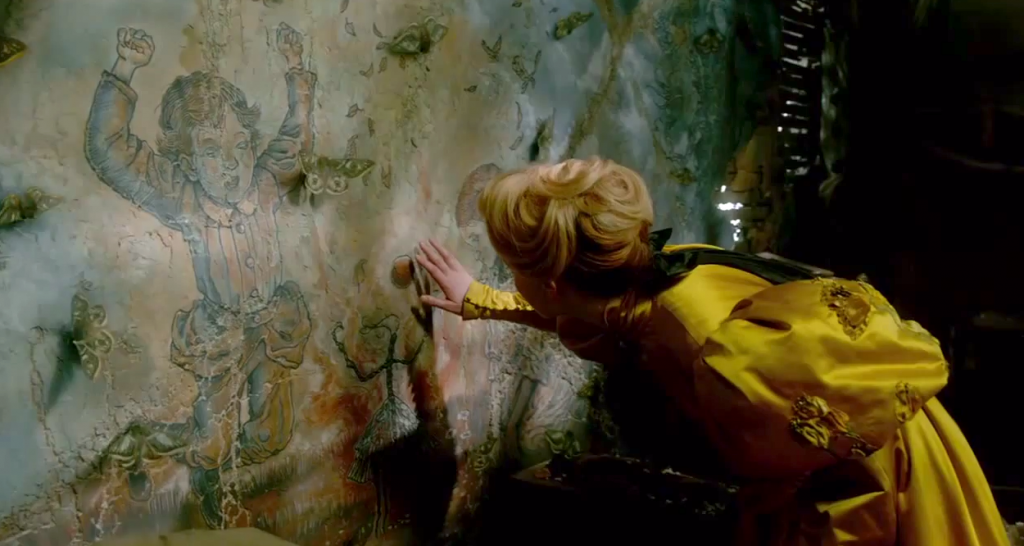
As the women finish their conversation about the relationship between the butterflies and moths, Lucille drops the butterfly on the ground which is then immediately devoured by a group of ants. This is very graphic with the camera zoomed to microscopic detail as we watch the ants eat the eyes of the butterfly. This is accompanied with an unsettling and surreal echoing soundtrack behind intense devouring noises. This not only highlights the danger Edith is in but also underlines the lack of empathy in these creatures, they only live to consume. This magnified view of dying insects happens again, but it is when Edith first arrives as Allerdale Hall. She removes her hair pin in front of a mirror, perhaps the beginning of her slow decline that is marked by costuming from the golden belle to a sickly ghost-like version of herself as she becomes more ill from Lucille’s poisoning. As she glances to the mantle piece the mirror sits on, there are a number of half dead flies, buzzing around with the last of their strength. Not only an indicator of the dankness and decay of Allerdale Hall, but it also reminds the audience that only black moths can survive here, the house is unsuitable for even flies to survive. Edith’s mistrust of the mansion is plain in her eyes.
Despite the film thus far foreboding the downfall of the butterfly, Del Toro introduces indicators that the plan of the Sharpe siblings will not be successful as they have previously been. After Edith and Thomas are married and they arrive at Allerdale Hall, they are greeted by a small dog that is instantly attracted to Edith. As an Easter egg and another example of Del Toro’s attention to detail as well continuity in his symbolism, this particular breed is a Papillon, the French word for butterfly. This is the first beacon of hope for Edith and her survival. The dog was previously owned by one of Thomas’s previous wives but was left for dead after she had died. Its survival in the barren Cumberland landscape signifies Edith’s actual fate, subsisting against all odds. It also compares Thomas to Lucille; Thomas is passive whereas Lucille is active. As we later learn it was Lucille who killed their mother, Lucille who murdered Edith’s father and Lucille who was the orchestrator for the murders of Thomas’s wives, the treatment of the dog then becomes clear as a comparison between the siblings and their murderous nature. Though Thomas is an accomplice, he helps Lucille with her crimes, he does not share her violence. Instead of killing the dog directly, he leaves it outside, hoping it would perish in the cold rather than actually having to execute it himself. Lucille, however, has no mercy calling the dog, “Come here, doggy! Little shit!” before violently snapping its neck. Dogs are animals that are especially highly regarded by humans and our relationship with them are second-to-none so their deaths on screen are significant. Del Toro’s choice of a dog truly drives the point home that Lucille has lost her humanity, just like the insects she mirrors. In this climax, the set design incorporates more and more butterflies, as pictured in Fig. 7. The house once dominated by only moths, the appearance of butterflies in one form or another signifies to the audience that Edith has hope.
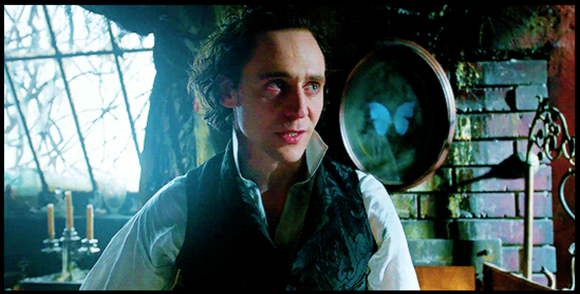
Moths are a particularly interesting example of the use of animals in film as the human-animal relationship is not very conventional. Unlike dogs, horses or more generally mammalian animals, insects (when not anthropomorphised) are completely inhuman. They are emotionless and totally alien in their appearance, which gives them negative connotations in the popular imagination. They have no agency in the film, so Del Toro employs them solely for their metaphoric value. Their lack of empathy comes to represent the same nature in Lucille, whilst also, of course, bearing cultural significance in their meaning. Another incredibly famous representation of moths in film is the 1991 classic The Silence of the Lambs, we can draw comparisons in both their symbolisms. Each mark death, with Hannibal Lecter placing the chrysalis of a moth in the mouths of his victims. The chrysalis being a symbol of change or transformation we could add this reading to Crimson Peak as well. Before the women begin to talk in the park scene, Lucille harvests a chrysalis from a tree and wraps it in a handkerchief. Though not given any explanation, this is potentially the first indicator that Edith’s story will not follow that of the previous three wives, this story is different.
Reference List
[1] Lynne Jim, ‘Mariposa de la Muerte’, Nature Watch, http://naturewatchaustin.blogspot.com/2019/06/mariposa-de-la-muerte.html [accessed 19/01/2021]
Bibliography
[1]Jim, Lynne, ‘Mariposa de la Muerte’, Nature Watch, http://naturewatchaustin.blogspot.com/2019/06/mariposa-de-la-muerte.html [accessed 19/01/2021]